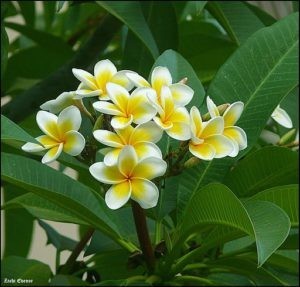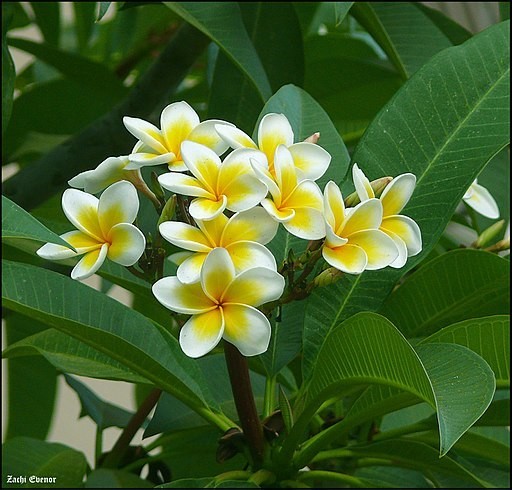Scientific name: Plumeria rubra
English common name: Frangipani
Lao name: Champa
Plant family: Apocynaceae
The various species of Frangipani are native to Mexico, Central America, the Caribbean and Polynesia. There are no species native to Asia, and yet the white and yellow Frangipani is the national flower of Laos!
So why is this the case? These plants are easy to grow, beautiful and fragrant, and so have been used to beautify gardens around the world for many years. They were probably introduced to Laos by the French during the colonial period, and have been a fixture ever since. They have naturalised throughout Asia, and often have spiritual or symbolic meaning.
In Laos Frangipani flowers are used in a wide variety of ceremonies and events. They are used to scent the water poured over the Buddha during Pi Mai (Laos New Year), can be used in the floral decorations for Baci ceremonies, are worn my women and children during dances and performances, and given as gifts to welcome people. These are just a few examples.

Photo from Wikimedia Commons
Botanically, Frangipani belongs to the Apocynaceae family, sometimes known as the “Dogbane” family. Many of the plants in this family are toxic, and some are so poisonous that consuming even a small amount is deadly. Most of these plants produce a milky sap, and if you get this on your skin you’ll develop a rash and be a bit uncomfortable for a few days. Here in Laos several plants in this family have traditional uses as hunting poisons or paralytics for fishing. Frangipani is not used in this way however.
The best time to see Frangipani in Laos is at the beginning of the rainy season in June-July, although they will continue to produce some flowers throughout the rainy period. The beautiful scent of the flowers is strongest at night. They are pollinated by moths, and so use a combination of their white colour and scent to attract these insects.
If you visit Luang Prabang you should take a stroll around the peninsular in the evening – the beautiful sunset is accompanied by the sweet smell of these blooms.
By Bryony Smart, PTK Botanist
Photo credit:
By Zachi Evenor, CC BY 3.0 (http://creativecommons.org/licenses/by/3.0), via Wikimedia Commons



